1. INTRODUCTION
The resonance happens when a characterized quantity/ quantities of two/more bodies' motion is repeated at regular periods of their revolution, i.e., it is nearly commensurable, or their proportion is near to the division of a number. It can be caught easily by the presence of small divisors at equations of motion integration. The phenomena of resonance can be utilized to avoid perturbation from the gravitational potentials. The mean motion resonance between two celestial bodies means repetition of the geometrical configuration orbits periodically, which can warranty stability. Therefore, it is suitable to present an accurate and rigorous model to describe such natural interactions.
Many works are devoted to studying the resonance phenomena in celestial mechanics. The most relevant studies are Celletti (1990);Gilthorpe et al. (1990);Delhaise & Morbidelli (1993);Breiter (1999);Costa Filho & Sessin (1999);Celletti & Chierchia (2000) and Breiter (2001a, 2001b, 2003). For numerous years, scientists have accounted for the perturbation of the third body as a fundamental issue of studying the resonance problem and its behavior along the run. The readers can refer to Broucke (2003);Prado (2003) to review the problem therein. The averaging technique is usually used to address the third-body effect; see, for example, Szebehely (1964);Roth (1982);Rickman & Froeschle (1983);Ferrer & Osácar (1994) and Rahoma (2014). It still represents a topic of work, especially when the resonance and long-term perturbations are investigated as; Henrard & Caranicolas (1989);Folta & Quinn (2006);Domingos et al. (2008) and Carvalho et al. (2009a, 2009b) and discussed the lunisolar effect on Earth satellites of highaltitude using one average-model over their short-periods, while Scheeres et al. (2001) and Khattab et al. (2020) used a doubly averaged model; one over the satellite is shortperiod and the other for the third body is one. Some articles have tried to solve the problem of third perturbation, neglecting the equatorial plane inclination; Carvalho et al. (2008, 2010);Lara (2010, 2011) and Rahoma & Abd El-Salam (2014). Also the direct solar radiation pressure can modify the resonance dynamics, see for instant, Musen (1960);Cook (1962);Kozai (1963);Sehnal (1970, 1975);Anselmo et al. (1983) ; El-Saftawy et al. (1998);El-Saftawy (2005) and El- Enna et al. (2006).
Pichierri et al. (2018), Chametla et al. (2020), and Lari et al. (2020) characterized the resonant studies comparing numerical simulations and semi-analytical formulae. Also, they described the Galilean satellites' future behavior over the lifetime of the Solar System and quantified the stability of the resonance.
The insufficient information and the unclear perception about Mercury leave many important questions unsettled about the solar system's origin and its early history. Mercury has been visited only during some space missions started by flyby Mariner 10 in 1974 and 1975. The distance of Mercury from the Sun varies from 0.3 Astronomical Unit (AU) up to 0.43 AU, which raises the Sun effect on any Mercurian orbiter from the coronal mass ejections, solar wind, solar flares in addition to the Sun attraction as a third body. The nearness of Mercury's orbit for the Sun affects Mercury's space environment than those on Earth dramatically. This will lead to significant modification for the orbit of any Mercurian orbiter and has great effects on the orbiter dynamics. The phasing of the orbiter with respect to the Sun and its position in the Mercury's magnetosphere will highly affect its dynamics.
2. HIGHLIGHT ON MERCURY MISSIONS
The proximity of the planet Mercury to the Sun, as well as its small size, still represents a mystery for astronomers. Neither the ground observations nor the space ones found any evidence for an atmosphere exist at any wavelength, whether infrared, optical, or radar, which may recommend that Mercury's surface may maintain many events in the solar system history. So, the missions to Mercury were started despite its extreme difficulties, as the amount of energy required for such mission and the intercept of the spacecraft's trajectory with Venus' orbit. Lately, Venus' gravity pull was utilized to modify a mission's transfer orbit.
Mariner 10 utilized Venus' gravitational attraction to reach Mercury for the first time to execute flybys of two planets in the same mission in Nov. 1973. Mariner 10 sent back different images for the sunlit hemisphere and discovered a field of dipole magnetic such that of Earth.
As a dual mission in 2000, ESA and JAXA announced starting to explore Mercury; BepiColombo, by contributing to Mercury Planetary Orbiter (MPO) and Mercury Magnetospheric Orbiter (MMO), respectively. Once they orbit the planet, they will start to explore its surface and environment comprehensively. BepiColombo was started in Oct. 2018, and it will reach Mercury after seven years with modification of its trajectory by nine times.
In August 2004, NASA launched MESSENGER to reach Mercury at polar orbit in Mar. 2011. By assisting the Earth's gravity, Venus' gravity, and Mercury itself, MESSENGER was orbited in a near-polar and highly elliptical orbit around Mercury twice every 24 hours.
There are many missions to Mercury that were planned in the present or in the future. It is helpful for such missions' design to prove the orbits from different perturbations that come from gravity or non-gravity.
The aim of this work is to highlight resonance value and investigate the resonances cases appearing due to commensurability of the mean motions of Mercury and the Sun as a third body. The objectives are located in presenting the resonant inclination behavior as a function of changing of orbital elements (argument of periapsis, eccentricity, longitude of the ascending node) at different values of the semi-major axis, i.e., the resonant inclination is the dependant variable while the orbital elements are independent variables.
3. PERTURBING FORCES MODELS
In the present work, the gravitational perturbations due to Mercury's oblateness and the Sun's gravity as a thirdbody, in addition to the non-gravitational perturbations due to Sun's coronal mass ejection, solar wind, and the solar radiation pressure, will be considered. As well as these perturbations, other forces, whether change significantly in time or random, have to add to the dynamics in further studies like Venus gravitational effects and/or Mercury's magnetic field effects, especially at Solar mass flux activity.
Within the accuracy respecting, the following assumptions will be introduced to simplify the dynamics sharpness.
-
1. The reference system center is the center of Mercury;
-
2. A Mercury's orbiter is considered as massless;
-
3. The Sun revolves in an apparent circular orbit about the Mercury, i.e. ft + ωt = θ, where ft is the true anomaly of the Sun, ωt is the periapsis argument of the Sun and θ is the mean longitude of the Sun.
-
4. The orbiter's motion is considered as Keplerian motion assuming the presence of the Sun's gravity and its radiation pressure as perturbing forces.
-
5. Suppose that the distance and the direction of the Sunorbiter are the same as that for Sun-Mercury.
-
6. Using the Keplerian orbital elements to characterize the orbiter's motion; a symbolizes for semi-major axis, e symbolizes for orbit's eccentricity, I symbolizes for inclination of the orbital plane due to the Mercury equatorial place, Ω symbolizes for orbit's longitude of ascending node, ω symbolizes for orbit's argument of periapsis and M symbolizes for orbiter's mean anomaly.
The Hamiltonian of the problem can be formulated as
where represents to canonical momentum vector, VM and Vt represent to Mercury’s and Sun gravitational field, respectively.
Recall the Laplace’s equation ; , solution for a scalar function; VM, using (r,δ,φ) as spherical coordinates on domain r > 0, 0 < δ < π, 0 ≤ φ ≤ 2π it can be expressed as a spherical harmonics infinite series, Arfken (2012).
Let the gravitational field of Mercury is an axially symmetry, where the axes origin is located at its center of mass, then the scalar function can be written as VM; see for instant Fitzpatrick (1970)
where μM is the Mercury’s gravitational parameter, RM is the Mercury’s equatorial radius, Jn are the zonal harmonic coefficients, J22 is the first tesseral harmonic, (r,δ) are the orbiter coordinates as appeared from Mercury’s center, Pn(sinδ) represent the Legendre Polynomials, f defined the true anomaly and finally, τ is standed for the Mercurian reference sidereal time.
To simplify the writing, let us use S = sinI, C = cosI, and , Abd El-Salam et al. (2006) and Rahoma et al. (2014).
The perturbation due to the third body is given by
where μt = GMt,ψ symbolizes to the Sun-Orbiter angle from the Mercury, is the position of orbiter relative to Mercury, Mt is the Sun's mass, and G symbolizes to the gravitational constant. Θ symbolizes to the mean motion of the Sun, for at symbolizes to the semi-major axis of the Sun's orbit as it appear from Mercury. For the model, retaining the disturbing function P2 and P3 (R2 and R3) in the summation yields;
where
where cosψ can be expressed as
with
-
α = cosω cos(Ω – ft – ωt) – cosI sinω sin(Ω – ft – ωt),
-
β = –sinω sinω cos(Ω – ft – ωt) – cosI cosω sin(Ω – ft – ωt)
Adopted from Abd El-Salam (2007) with permission of Elsevier.
All objects in the solar system suffer from the sun’s radiation force that is called solar radiation pressure especially those at closer distances from the Sun. Solar radiation pressure significantly affects the smaller bodies as their surface area to mass ratio (Ai / m) are large somewhat unless their orbital position lies in the orbited body shadow. The orbital elements are periodically changed as a result of this force. In view of the assumptions, the surface elements contribution to total acceleration can be formulatted as:
where S0 = 1,370 W/m2 symbolizes to the solar constant (identical to the average distance of Mercury-Sun aM–s) Lewis (2004), γi symbolizes to the incidence angle, βi symbolizes to the coefficient of reflection for ith orbiter’s surface and symbolizes to the unit vector of Orbiter-Sun direction, where the reference frame is the Mercurocentric equator, and it can be written as
where θ(= Θt)t symbolizes to time, and ε symbolizes to the obliquity (Mercurian equator plane with respect to the ecliptic).
Solar mass ejects protons to the surrounding space due to solar wind, solar flares and corona mass ejection. Actually, solar wind is the most important force in this ejection. Typically at Earth, solar wind speed nearly 400 km/s, Breen et al. (2002) and its density nearly 10 protons/cm3. On other hand, thanks Mariner 10, at Mercury solar wind speed nearly 423 km/s while its density nearly 60 protons/cm3.
Assume that the Mercurian orbiter is impacted by inelastic particles and the angular span of ejections are spherical envelope, The solar wind perturbing acceleration and coronal mass ejections perturbing acceleration can be formulated, respectively, as, see Abd El-Salam (2007),
where(Ai / m)SW defined area-mass ratio which exposed to solar wind, nSW symbolizes to particle density, υSW symbolizes to solar wind velocity, and MP is the proton mass, While (Ai / m)CME defined area-mass ratio which exposed to coronal mass ejection , VCME symbolizes to the volume, MCME symbolizes to the mass and υCME symbolizes to coronal mass ejections velocity.
4. CANONICAL FORMULATION AND ORDERING
Selecting Delaunay variables as canonical ones which can be defined as
Now to insert the forces into the problem’s Hamiltonian as a adopted solution technique, they would be rewritten as a gradient for combined function (let Φ⊙) i.e.
To obey equation (11),
where is an explicitly time dependence within the Sun’s mean longitude θ(= Θt).
To recover equations autonomous, a new conjugate pair of variables; (k,K), will be setted to Delaunay variables where k = Θt + const.
Utilizing the extended Delaunay variables, the Hamiltonian of the three forces can be formulated as
with
where Fm,n = f + g + mh + nk.
The non-vanishing coefficients for C’s are
with Cε = cosε, Sε = sinε
5. ASSESSMENT OF THE ORDERS OF MAGNITUDE
The magnitude orders φ(x),x = 1,2,… in view of a small parameter; ∈ for perturbing terms can be clarified as, see Abd El-Salam (2007),
In our problem, the Mercurian coefficients J2 ≃ C22 is considered as a first order. Also the orbiter’s mean motion around Mercury varies from 2,500 rev./day up to 100 rev./ day. Also, the solar mean motion Θ ≅ 0.1 rev./day. i.e, R2 is considered as of the first order. Finally, J3, J4, J5 are are considered of the second order.
Now the magnitude order for each considered nongravitational force is determined by a single nominal magnitude which is
Therefore, truncating the series of the Mercurian gravitational potential up to J5, the perturbing Hamiltonians (1) can be written as, Abd El-Salam et al. (2006):
with
where the dimensionless quantities are defined as:
6. METHODOLOGICAL TECHNIQUE
Lie transforms method; initially developed for vector fields by Deprit (1969) and Kamel (1969), and others, is a powerful procedure to deal with a perturbed Hamiltonian depending on a small parameter. This method allows recursive routines to transform the original system perturbation to another one which features by flexiable properties.
Let the Hamiltonian of a problem be a function of canonical variables (the coordinates and momenta) i.e. , the motion equations can be formulated as:
In a problem, considering a small parameter; ε, and the Hamiltonian may be expand as:
where is the unperturbed Hamiltonian (integrable part).
To improve the solution considering the perturbing Hamiltonian , a one /or more canonical transformations analytic in ε at ε = 0 is required to remove the fast and slow angles from respectively.
The transformed Hamiltonians and its corresponding generators can be formulated as:
Clearly from the described technique to deal with the our perturbed Hamiltonian H(l, g, h, k, L, G, H, K; J2), we have to do two canonical transformations to eliminate:
-
1- two fast variables namely the orbiter’s mean anomaly l in addition to the solar mean longitude k to be H*(–, g, h, –, L, G, H, K; J2).
-
2- two slow variables, g, h to be H**(–, –, –, –, L, G, H, K; J2). The first averaging process yields
with
with
and the second averaging process yields
with
The corresponding generator can be written in the form
7. RESONANCE CAPTURE
Suppose a periodic mechanical system has a number of natural frequencies.Whenever two or more of these frequencies are nearly commensurable, resonance arises. Simply this may be formulated n1 / n2 = p / q where n1 and n2 are the two natural frequencies and p and q are small prime integers.
The theoretical problem in cases of near commensurability motion is due to the small divisors appearance in the developments of the usual asymptotic representations of the solution. These divisors have the form pn1 – qn2, leading to an unsatisfactory solution.
In celestial mechanics theses problems type present themselves clearly. Like the Earth’s satellite critical inclination as a result of near-commensurability of draconic and the anomalistic frequencies. In addition,the mean motion of an artificial satellite may be commensurable with the angular velocity of the primary body.
The resonance cases will be created when the denominators generating function become sufficiently small or vanish. These conditions can be formulated as:
where
and
If we substitute H = Gcos I in the equation (24), we get a quadratic function in the inclination as:
The solution (25) yields the different resonant inclinations as
where
8. OUTCOME SIMULATIONS
In this section, the behaviour of the resonant inclination is investigated as a function of orbital elements. A following mercurian data are imposed in the simulations, Semi-major axis; aM = 5.791 × 107 km, Eccentricity eM = 0.205, Orbital period is 87.969 days, Inclination; I = 7.0°, Longitude of perihelion, ω = 77.46°, Longitude of ascending node, Ω = 48.33° and Orbit Obliquity is 0.1°. In addition to, Mercury’s Mass MM = 3.302 × 1023 km, RM = 2,439 km, μM = 0.02203 × 106 km3s–2, J2 = 60 × 10–6 and J22 = 10 × 10–6. In the light of equation (25) we can treat the resonant inclination as a dependant variable and the orbital elements as independent variables. In each case study we will fix all orbital elements except that element we need to observe the behaviour of the resonant inclination under its change. In each figure we have fixed two orbital elements, see each figure caption. Also different colored curves are plotted in each figure, each color corresponds to a specified value of the semi-major axis as shown in the legend attached to the right of the diagram.
In this case we study the behaviour of the resonant inclination in degree in terms of changing the argument of periapsis.
It is observed that all curves in Figs. 1–4 meet at two resonant inclinations, a relatively small perturbations in these inclinations are observed. These results can be summerized in the following Table 1.
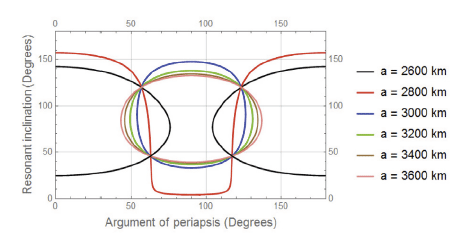



In this case we study the behaviour of the resonant inclination in degree in terms of changing the eccentricity Figs. 5–8. The dynamics is simple. Each case is relatively represented by constant linear function except at the semimajor axis equal 3,200 km and 3,400 km. The dynamics in these two cases are also approximately linea form e = 0 to about e = 0.1 and beyond that it bahaves nonlinearly, the two roots meet at the following values, see Table 2.
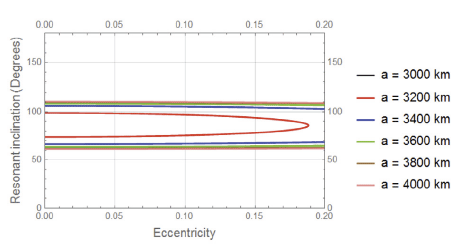

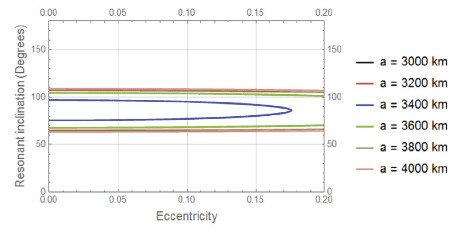
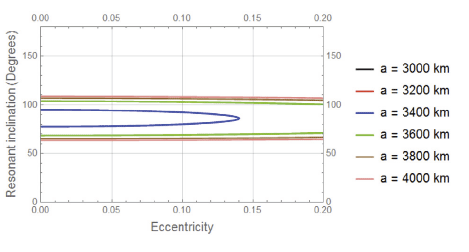
In this case we study the behaviour of the resonant inclination in degree in terms of changing the longitude of the ascending node.
It is observed that all curves in Figs. 9–12 meet at two resonant inclinations, a relatively small perturbations in these inclinations are observed due to the change in the eccentricity from figure to figure. These results can be summerized in the following Table 3.
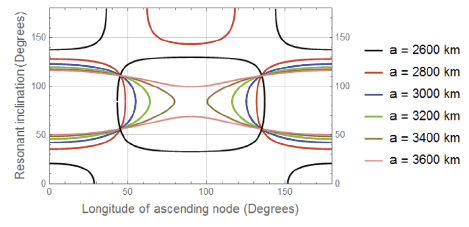
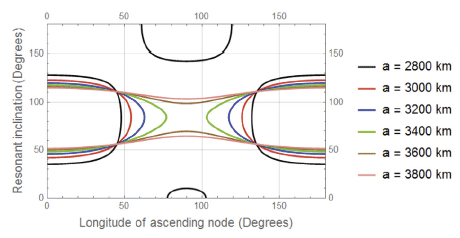
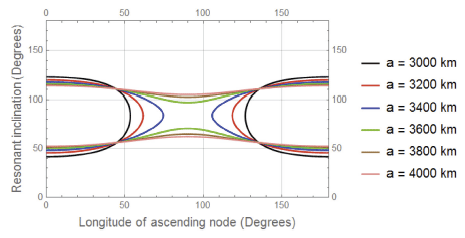

9. Conculsion
Due to the importance of the resonance dynamics, We have treated the problem of resonance caused by the some gravitational as well as nongravitational perturbations. The treated problem is of special interest due to many missions planned to Mercury, in past, present and in future. The important advantage of resonance study is to protect and preserve the orbits from the perturbations due to different gravitational forces. In order to make the problem tractable, we utilized some simplifying assumptions. The considered force model is constructed. Then the Deluanay canonical set is intorduced. We formulate the problem using the Hamiltonian framework, and orderd the Hamiltonian, then we used Lie transform to doubly average the problem.We compute the resonance capture. At the end of the work, we give some numerical simulations to capture the resonant inclinations, i.e. for eccentricity e = 0.2, and at Ω = 90˚, there are two resonant inclinations I = 46˚ and 120˚. Also, at ω = 45˚, there are two resonant inclinations I = 55˚ and 111˚ at different values for semi-major axis.












